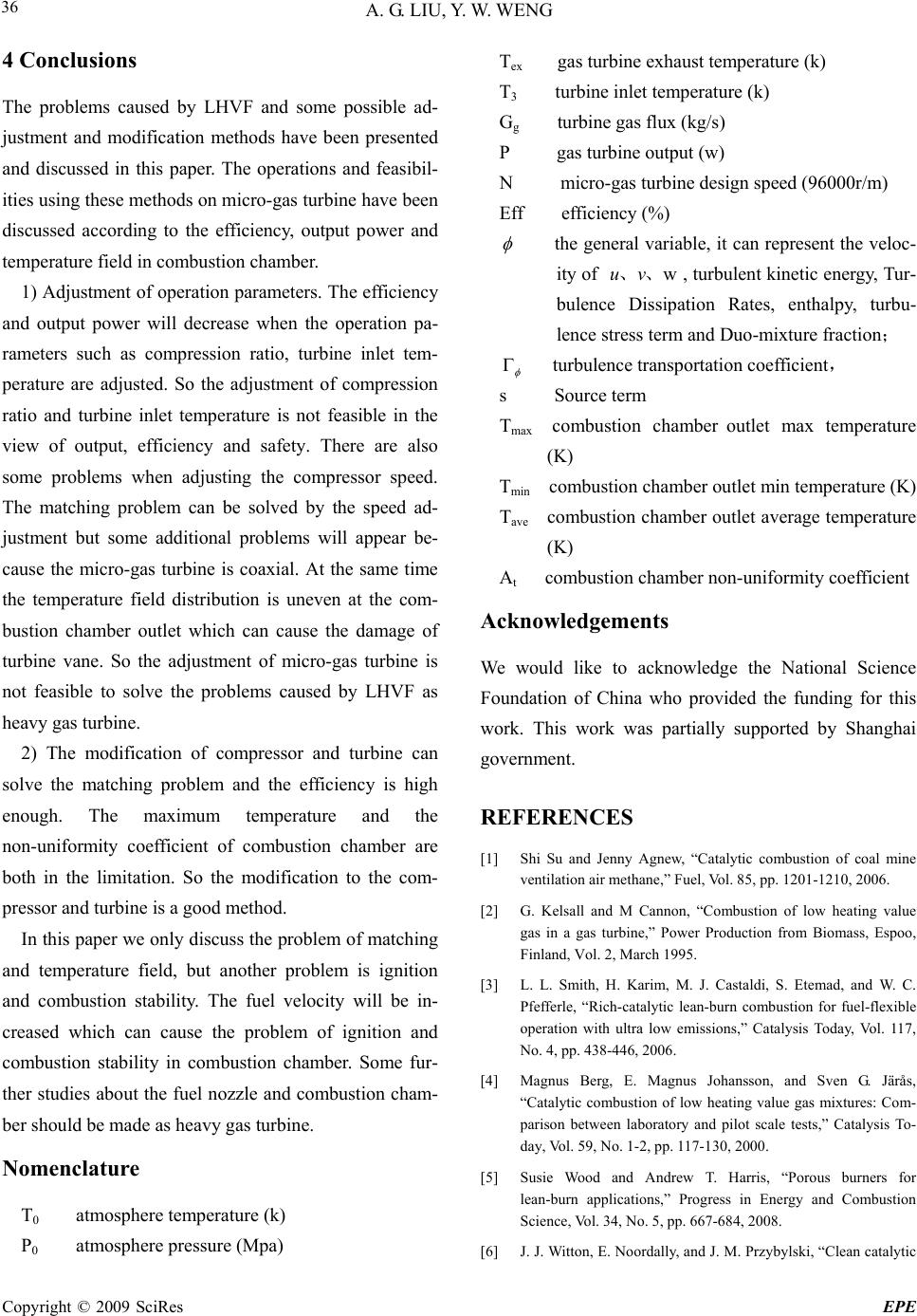
A. G. LIU, Y. W. WENG
Copyright © 2009 SciRes EPE
36
4 Conclusions
The problems caused by LHVF and some possible ad-
justment and modification methods have been presented
and discussed in this paper. The operations and feasibil-
ities using these methods on micro-gas turbine have been
discussed according to the efficiency, output power and
temperature field in combustion chamber.
1) Adjustment of operation parameters. The efficiency
and output power will decrease when the operation pa-
rameters such as compression ratio, turbine inlet tem-
perature are adjusted. So the adjustment of compression
ratio and turbine inlet temperature is not feasible in the
view of output, efficiency and safety. There are also
some problems when adjusting the compressor speed.
The matching problem can be solved by the speed ad-
justment but some additional problems will appear be-
cause the micro-gas turbine is coaxial. At the same time
the temperature field distribution is uneven at the com-
bustion chamber outlet which can cause the damage of
turbine vane. So the adjustment of micro-gas turbine is
not feasible to solve the problems caused by LHVF as
heavy gas turbine.
2) The modification of compressor and turbine can
solve the matching problem and the efficiency is high
enough. The maximum temperature and the
non-uniformity coefficient of combustion chamber are
both in the limitation. So the modification to the com-
pressor and turbine is a good method.
In this paper we only discuss the problem of matching
and temperature field, but another problem is ignition
and combustion stability. The fuel velocity will be in-
creased which can cause the problem of ignition and
combustion stability in combustion chamber. Some fur-
ther studies about the fuel nozzle and combustion cham-
ber should be made as heavy gas turbine.
Nomenclature
T0 atmosphere temperature (k)
P0 atmosphere pressure (Mpa)
Tex gas turbine exhaust temperature (k)
T3 turbine inlet temperature (k)
Gg turbine gas flux (kg/s)
P gas turbine output (w)
N micro-gas turbine design speed (96000r/m)
Eff efficiency (%)
the general variable, it can represent the veloc-
ity of , turbulent kinetic energy, Tur-
bulence Dissipation Rates, enthalpy, turbu-
lence stress term and Duo-mixture fraction;
wuv
、、
turbulence transportation coefficient,
s Source term
Tmax combustion chamber outlet max temperature
(K)
Tmin combustion chamber outlet min temperature (K)
Tave combustion chamber outlet average temperature
(K)
At combustion chamber non-uniformity coefficient
Acknowledgements
We would like to acknowledge the National Science
Foundation of China who provided the funding for this
work. This work was partially supported by Shanghai
government.
REFERENCES
[1] Shi Su and Jenny Agnew, “Catalytic combustion of coal mine
ventilation air methane,” Fuel, Vol. 85, pp. 1201-1210, 2006.
[2] G. Kelsall and M Cannon, “Combustion of low heating value
gas in a gas turbine,” Power Production from Biomass, Espoo,
Finland, Vol. 2, March 1995.
[3] L. L. Smith, H. Karim, M. J. Castaldi, S. Etemad, and W. C.
Pfefferle, “Rich-catalytic lean-burn combustion for fuel-flexible
operation with ultra low emissions,” Catalysis Today, Vol. 117,
No. 4, pp. 438-446, 2006.
[4] Magnus Berg, E. Magnus Johansson, and Sven G. Järås,
“Catalytic combustion of low heating value gas mixtures: Com-
parison between laboratory and pilot scale tests,” Catalysis To-
day, Vol. 59, No. 1-2, pp. 117-130, 2000.
[5] Susie Wood and Andrew T. Harris, “Porous burners for
lean-burn applications,” Progress in Energy and Combustion
Science, Vol. 34, No. 5, pp. 667-684, 2008.
[6] J. J. Witton, E. Noordally, and J. M. Przybylski, “Clean catalytic